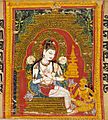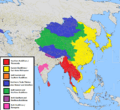Mahayana facts for kids
|
Basic terms |
|
|
People |
|
|
Schools |
|
|
Practices |
|
|
study Dharma |
|
Mahayana (pronounced Mah-hah-YAH-nah) is one of the two main types of Buddhism. It started in India a long, long time ago. The word "Mahayana" means "Great Vehicle." This name shows that Mahayana aims to help many, many people reach enlightenment, which is a state of deep wisdom and peace.
Mahayana Buddhism teaches that everyone has the potential to become a Buddha. It also focuses a lot on compassion and helping others. Zen Buddhism, which is popular in places like Japan, is a kind of Mahayana Buddhism that was also shaped by Confucianism.
Contents
What is Mahayana Buddhism?
Mahayana Buddhism is a big branch of the Buddhist religion. It grew and changed over many centuries. It spread from India to places like China, Korea, Japan, Vietnam, and Tibet.
Key Ideas of Mahayana
Mahayana Buddhism has some special ideas that make it different from other types of Buddhism.
The Bodhisattva Path
One of the most important ideas in Mahayana is the Bodhisattva. A Bodhisattva is someone who has reached a very high level of enlightenment. They could enter Nirvana (a state of perfect peace and freedom from suffering). But instead, they choose to stay in the world. They do this to help all other living beings become enlightened too.
Bodhisattvas are driven by great compassion (karuna) and wisdom (prajna). They make a promise, called a vow, to save all beings. They work tirelessly to guide others on the path to enlightenment.
Many Buddhas
In Mahayana, people believe there are many Buddhas. These are not just historical figures like Gautama Buddha. There are also Buddhas who exist in different realms or dimensions. They are still teaching and helping beings right now. Some famous Buddhas in Mahayana include Amitābha and Vairocana.
Buddha-Nature
Another key idea is "Buddha-nature." This means that every single living being has the potential to become a Buddha. It's like a seed of enlightenment hidden inside everyone. Mahayana teachings help people discover and grow this inner Buddha-nature.
Wisdom and Emptiness
Mahayana Buddhism also teaches about "emptiness" (shunyata). This doesn't mean nothing exists. Instead, it means that things don't have a fixed, unchanging nature of their own. Everything is connected and always changing. Understanding this helps people let go of attachments and see the world more clearly.
Important Figures and Texts
Many important teachers and texts shaped Mahayana Buddhism.
Great Teachers
- Nagarjuna: He was a very important philosopher who lived around the 2nd century CE. He helped explain the idea of emptiness in a deep way. Some people even call him the "second Buddha."
- Bodhidharma: He is known for bringing Zen Buddhism to China. He is often shown meditating deeply.
Important Sutras
Mahayana has many important scriptures called "sutras." These are like sacred books that contain the teachings of the Buddha.
- Prajnaparamita Sutras: These sutras focus on wisdom and emptiness. The Diamond Sutra is a very famous one. It is one of the oldest known printed books in the world.
- Lotus Sutra: This sutra teaches that all beings can achieve Buddhahood. It also emphasizes the idea of skillful means (upaya), which means Buddhas and Bodhisattvas use different methods to help people depending on their needs.
How Mahayana Spread
Mahayana Buddhism started in India and then spread widely.
- It traveled along the Silk Road to China, where it mixed with local ideas like Taoism and Confucianism.
- From China, it went to Korea, Japan, and Vietnam.
- It also spread to Tibet, where it developed into Tibetan Buddhism, led by figures like the Dalai Lama.
Many great monasteries and universities, like the Nalanda Mahavihara in India, were important centers for studying Mahayana Buddhism.
Images for kids
-
Mahāyāna Buddhist triad, including Bodhisattva Maitreya, the Buddha, and Bodhisattva Avalokiteśvara. 2nd–3rd century CE, Gandhāra.
-
Seated Avalokiteshvara bodhisattva. Gandharan, from Loriyan Tangai. Kushan period, 1st – 3rd century CE. Indian Museum, Calcutta.
-
Cave complex associated with the Mahāsāṃghika sect. Karla Caves, Mahārāṣtra, India.
-
Ruins of the Nalanda Mahavihara (Great Monastery) in Bihar, a major center for the study of Mahāyāna Buddhism.
-
The use of mandalas was one new feature of Tantric Buddhism, which also adopted new deities such as Chakrasamvara.
-
Avalokiteśvara, the bodhisattva of compassion. Ajaṇṭā Caves, Maharashtra, India.
-
Guanyin (Avalokiteśvara) with multiple arms symbolizing upaya and great compassion, Leshan, China.
-
A statue of the Mahāyāna philosopher Nagarjuna, founder of the Madhyamaka school.
-
Zen master Bodhidharma meditating, Ukiyo-e woodblock print by Tsukioka Yoshitoshi, 1887.
-
Frontispiece of the Chinese Vajracchedikā Prajñāpāramitā Sūtra, the oldest known dated printed book in the world.
-
Fo Guang Shan Buddha Museum, Taiwan.
-
The 14th Dalai Lama Tenzin Gyatso with Desmond Tutu in 2004.
See also
 In Spanish: Mahāyāna para niños
In Spanish: Mahāyāna para niños

























